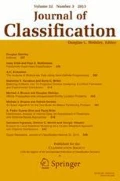Abstract
Two-mode partitioning is a relatively new form of clustering that clusters both rows and columns of a data matrix. In this paper, we consider deterministic two-mode partitioning methods in which a criterion similar to k-means is optimized. A variety of optimization methods have been proposed for this type of problem. However, it is still unclear which method should be used, as various methods may lead to non-global optima. This paper reviews and compares several optimization methods for two-mode partitioning. Several known methods are discussed, and a new fuzzy steps method is introduced. The fuzzy steps method is based on the fuzzy c-means algorithm of Bezdek (1981) and the fuzzy steps approach of Heiser and Groenen (1997) and Groenen and Jajuga (2001). The performances of all methods are compared in a large simulation study. In our simulations, a two-mode k-means optimization method most often gives the best results. Finally, an empirical data set is used to give a practical example of two-mode partitioning.
Similar content being viewed by others
References
BAIER, D., GAUL, W., and SCHADER, M. (1997), “Two-Mode Overlapping Clustering with Applications in Simultaneous Benefit Segmentation and Market Structuring,” in Classification and Knowledge Organization, eds. R. Klar and O. Opitz, Heidelberg: Springer, pp. 557–566.
BEZDEK, J. C. (1981), Pattern Recognition with Fuzzy Objective Function Algorithms, New York: Plenum Press.
BOCK, H. H. (1974), Automatische Klassifikation, Göttingen: Vandenhoeck & Ruprecht.
CASTILLO, W. and TREJOS, J. (2002), “Two-Mode Partitioning: Review of Methods and Application of Tabu Search,” in Classification, Clustering and Data Analysis, eds. K. Jajuga, A. Sololowksi, and H. Bock, Berlin: Springer, pp. 43–51.
DESARBO, W. S. (1982), “GENNCLUS: New Models for General Nonhierarchical Clustering Analysis,” Psychometrika, 47 (4), 449–475.
DOLAN, E. D. and MORÉ, J. J. (2002), “Benchmarking Optimization Software with Performance Profiles,” Mathematical Programming, 91, 201–213.
DOREIAN, P., BATAGELJ, V., and FERLIGOJ, A. (2004), “Generalized Blockmodeling of Two-Mode Network Data,” Social Networks, 26, 29–53.
DOREIAN, P., BATAGELJ, V., and FERLIGOJ, A. (2005), Generalized Blockmodeling, Cambridge University Press.
GAUL, W. and SCHADER, M. (1996), “A New Algorithm for Two-Mode Clustering,” in Data Analysis and Information Systems, eds. H. Bock and W. Polasek, Heidelberg: Springer, pp. 15–23.
GLOVER, F. (1986), “Future Paths for Integer Programming and Links to Artificial Intelligence,” Computers and Operations Research, 13, 533–549.
GROENEN, P. J. F., and JAJUGA, K. (2001), “Fuzzy Clustering with Squared Minkowski Distances,” Fuzzy Sets and Systems, 120, 227–237.
HANSOHM, J. (2001), “Two-Mode Clustering with Genetic Algorithms,” in Classification, Automation, and New Media, Berlin: Springer, pp. 87–93.
HARTIGAN, J. A. (1975), Clustering Algorithms, New York: John Wiley and Sons.
HEISER, W. J. and GROENEN, J. (1997), “Cluster Differences Scaling with a Within-Clusters Loss Component and a Fuzzy Successive Approximation Strategy to Avoid Local Minima,”Psychometrika, 62(1), 63–83.
HUBERT, L. and ARABIE, P. (1985), “Comparing Partitions,” Journal of Classification, 2, 193–218.
MILLIGAN, G.W. (1980), “An Examination of the Effect of Six Types of Error Perturbation on Fifteen Clustering Algorithms,” Psychometrika, 45(3), 325–342.
MIRKIN, B. (2005), Clustering for Data Mining: A Data Recovery Approach, Boca Raton FL: Chapman & Hall.
MIRKIN, B., ARABIE, P., and HUBERT, L. J. (1995), “Additive Two-Mode Clustering: The Error-Variance Approach Revisited,” Journal of Classification, 12, 243–263.
NOMA, E. and SMITH, D. R. (1985), “Benchmark for the Blocking of Sociometric Data,” Psychological Bulletin, 97(3), 583–591.
ROCCI, R. and VICHI, M.(2008), “Two-Mode Multi-Partitioning,” Computational Statistics & Data Analysis, 52, 1984–2003.
SCHEPERS, J., CEULEMANS, E., and VAN MECHELEN, I. (2008), “Selecting among Multi-Mode Partitioning Models of Different Complexities: A Comparison of Four Model Selection Criteria,” Journal of Classification, 25, 67–85.
TREJOS, J. and CASTILLO, W. (2000), “Simulated Annealing Optimization for Two-Mode Partitioning,” in Classification and Information at the Turn of the Millenium, eds. W. Gaul and R. Decker, Heidelberg: Springer, pp. 135–142.
TSAO, E. C. K., BEZDEK, J. C., and PAL, N. R. (1994), “Fuzzy Kohonen Clustering Networks,” Pattern Recognition, 27(5), 757–764.
VAN LAARHOVEN, P. J. M. and AARTS, E. H. L. (1987), Simulated Annealing: Theory and Applications, Eindhoven: Kluwer Academic Publishers.
VAN MECHELEN, I., BOCK, H. H., and DE BOECK, P. (2004), “Two-Mode Clustering Methods: A Structured Overview,” Statistical Methods in Medical Research, 13, 363–394.
VICHI, M. (2001), “Double k-Means Clustering for Simultaneous Classification of Objects and Variables,” in Advances in Classification and Data Analysis. Studies in Classification, Data Analysis, and Knowledge Organization, eds, S. Borra, R. Rocchi, and M. Schader, Heidelberg: Springer, pp. 43–52.
Author information
Authors and Affiliations
Corresponding author
Additional information
We would like to thank two anonymous referees whose comments have improved the quality of this paper. We are also grateful to Peter Verhoef for providing the data set used in this paper.
Rights and permissions
About this article
Cite this article
van Rosmalen, J., Groenen, P.J.F., Trejos, J. et al. Optimization Strategies for Two-Mode Partitioning. J Classif 26, 155–181 (2009). https://doi.org/10.1007/s00357-009-9031-2
Published:
Issue Date:
DOI: https://doi.org/10.1007/s00357-009-9031-2




